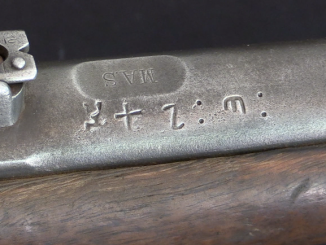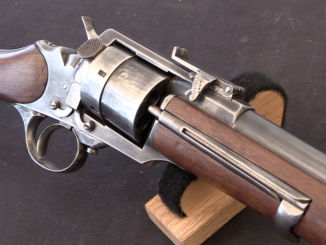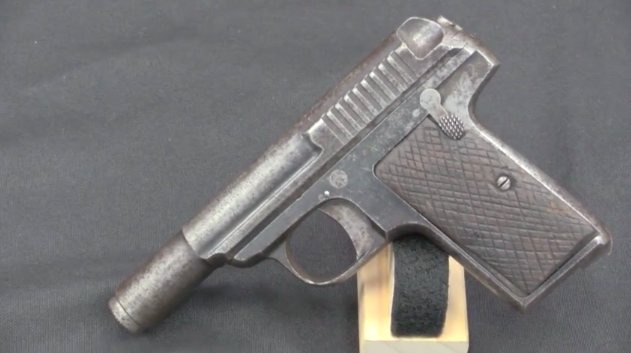This didn’t come out as well as I was hoping (one of the stage videos got corrupted and the others don’t show the shooting stages as well as I’d anticipated), but I will do better in future work. The gun, on the other hand, performed much better than I was expecting!
The Star Model 1914 was a pistol purchased by the French army starting in 1915 as an emergency wartime substitute standard sidearm alongside the Ruby. The Star was a more expensive gun, but also higher quality than many of the Ruby clones. It is a single-action, simple blowback action chambered for .32 ACP (7.65mm Browning) with a single-stack 9-round magazine. I did have to download the magazine to 8 rounds for it to be reliable, but that may well just the result of wear and tear on a century-old magazine.
The match where I am shooting today is designed for backup guns, like compact automatics and snub-nosed revolvers. Each stage is designed for 5-10 rounds, with no mandatory reloads – which makes it a good venue for me to use a gun like, which I only have a single magazine for. Note that because of the wide variety non non-range-safe ways people carry backup guns, the match stages never begin with a live gun holstered. Instead, you substitute a dummy gun in your carry style of choice (for me today, a 1916 pattern French Ruby holster). At the buzzer, you draw the dummy gun and then swap it for your real gun.
Overall, I placed much better than I had expected – tied for 4th out of 28 shooters!




Congratulations… Gun seems bit forcing back up size…
Your secondary is your secondary until it becomes your primary. 😉
I (like undoubtedly many) believed the received wisdom that these Spanish guns ‘modest and had a lot to be modest about’ and was pleasantly surprised by its showing. Though weak, they were available (in large and eventually ‘very large’ numbers = 300,000 WWI x Ruby alone at upto 30,000 per month), reasonable back up guns and a lot better than the alternative – which was nothing and an excellent buy / option for the French.
300.000 its the number of Rubys manufactured by Gabilondo alone. If you add all the manufacturers the numbers rise to 700K+
Spain had been shaping up as an industrial power right around 1900 and later. They had their own minerals mining, steel production and as we see plenty of firearms to offer. One has to wonder how this seemingly prosperous country slipped into civil war.
Oh that is a long and convoluted story going back to the reconquista at least. All of history really. Spain is a multi-ethnic country that basically has a tug-of-war (pun not intended) between the central power Castile with its capital Madrid striving to centralize power and the various regions, that are also ethnically different like Galicia, Basque country, Catalonia etc. etc., that wanted more a federalized nation. alsothe various regions developed at very different speeds. Catalonia has historically and to htis day been one of the best developed and richest areas, the Basque country had the advantage of mineral deposits adn easy ocean access fascilitating industrial development. Whereas the central highlands posed their own problems for development and were mostly rural and agricultural. But Castile had the military power to dominate the rest.
And as can be seen in the current troubles between Catalonia and Madrid this conflict has not really ended yet.
Yes, it seems to be that way. Madrid’s action against Catalonian activists is deplorable; it supports your assertion. Thanks for explanation.
nice run, the old girls still got it
The number of handguns sold was huge. 816,875 automatic pistols were purchased by France (mainly Rubys, and about 30.000 Star mod. 1914), but also 512,950 revolvers, mainly 8 mm swig-out cylinder (copies of Colt, S&W and others) along with about 100,000 top break revolvers (copies of S&W nº 3 DA) in cals .44, .455 and 10.35 mm, purchased by France, Great Britain, Italy and Romania.
The Star pistol was well made but Rubys were of varying quality. For example, Unceta (Astra) and B. Echeverria (Star) Ruby were also well made, but others were scrap-iron, and part of them were rejected in quality controls. However Spanish handguns were the core of allied side arms. Only the British continued to make their Webley revolvers (though also purchased .455 top break revolvers).
Gracias para su comentario! Very interesting and informative. I seem to recall Spanish-made Bodeo revolvers too, in addition to the aforementioned 10.35mm caliber S&W top-break revolvers and swing-out cylinder versions. Before WWI, there were Basque manufactories that turned out copies of the Smith and Wesson Russian and the various Merwin-Hulbert open-top revolver designs, as well as copies of various Belgian types.
You are right, Italy bought Spanish copies of Bodeo Mod. 1889 beside the break open S&W type (called “Pistola a rotazione Tettoni modello 1916” or Orbea-Tettoni), both in cal. 10.35mm. Copies of Nagant and Pieper in 8mm were also sold to Romania. France bought the major part of the guns (largely Rubys and swing out revolvers or “92 Espagnol”) but part of these were supplied to their allies.
The Inspector Clouseau faux French accent was just awesome.
Reference to the Steve Martin Pink Panther movie adaptations imfdb.org
Wow! Now that was a great presentation: history, context, shooting technique; you checked all the boxes.
As it is Spanish and has a detachable magazine it is more a relooked version of the La Lira pistol than a copy of the Manlicher 1905 🙂